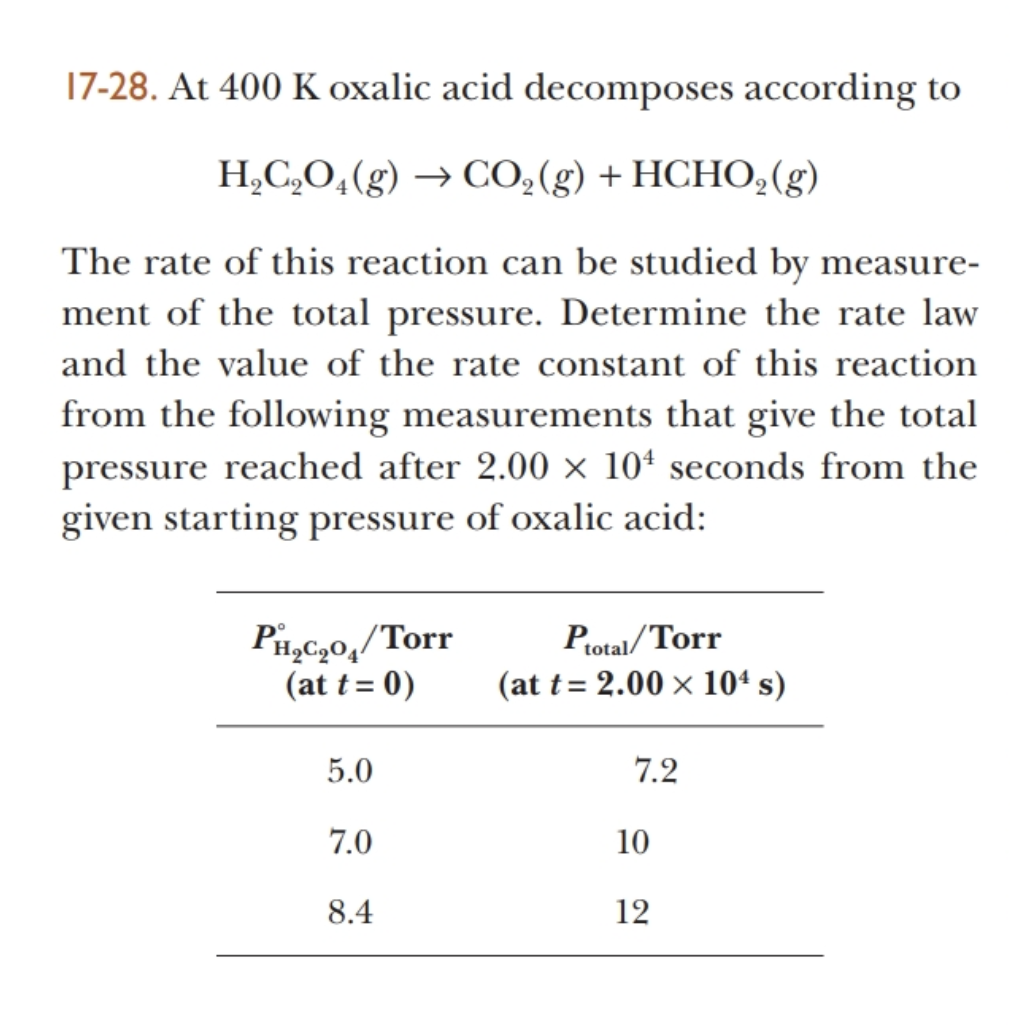17-28. At 400 K oxalic acid decomposes according to H,C,O,(g) → CO,(g) + HCHO,(g) The rate of this reaction can be studied by measure- ment of the total pressure. Determine the rate law and the value of the rate constant of this reaction from the following measurements that give the total pressure reached after 2.00 × 10ª seconds from the given starting pressure of oxalic acid: PH,C,0,/Torr (at t = 0) Protal/Torr (at t = 2.00 × 104 s) 5.0 7.2 7.0 10 8.4 12
17-28. At 400 K oxalic acid decomposes according to H,C,O,(g) → CO,(g) + HCHO,(g) The rate of this reaction can be studied by measure- ment of the total pressure. Determine the rate law and the value of the rate constant of this reaction from the following measurements that give the total pressure reached after 2.00 × 10ª seconds from the given starting pressure of oxalic acid: PH,C,0,/Torr (at t = 0) Protal/Torr (at t = 2.00 × 104 s) 5.0 7.2 7.0 10 8.4 12
Chemistry & Chemical Reactivity
9th Edition
ISBN:9781133949640
Author:John C. Kotz, Paul M. Treichel, John Townsend, David Treichel
Publisher:John C. Kotz, Paul M. Treichel, John Townsend, David Treichel
Chapter14: Chemical Kinetics: The Rates Of Chemical Reactions
Section: Chapter Questions
Problem 86IL: The acid-catalyzed iodination of acetone CH3COCH3(aq) + I2(aq) CH3COCH2I(aq) + HI(aq) is a common...
Related questions
Question

Transcribed Image Text:17-28. At 400 K oxalic acid decomposes according to
H,C,O,(g) → CO,(g) + HCHO,(g)
The rate of this reaction can be studied by measure-
ment of the total pressure. Determine the rate law
and the value of the rate constant of this reaction
from the following measurements that give the total
pressure reached after 2.00 × 10ª seconds from the
given starting pressure of oxalic acid:
Piyc40,/Torr
(at t= 0)
Potal/Torr
(at t= 2.00 × 104 s)
5.0
7.2
7.0
10
8.4
12
Expert Solution
This question has been solved!
Explore an expertly crafted, step-by-step solution for a thorough understanding of key concepts.
This is a popular solution!
Trending now
This is a popular solution!
Step by step
Solved in 5 steps with 6 images

Knowledge Booster
Learn more about
Need a deep-dive on the concept behind this application? Look no further. Learn more about this topic, chemistry and related others by exploring similar questions and additional content below.Recommended textbooks for you

Chemistry & Chemical Reactivity
Chemistry
ISBN:
9781133949640
Author:
John C. Kotz, Paul M. Treichel, John Townsend, David Treichel
Publisher:
Cengage Learning

Chemistry & Chemical Reactivity
Chemistry
ISBN:
9781337399074
Author:
John C. Kotz, Paul M. Treichel, John Townsend, David Treichel
Publisher:
Cengage Learning

Chemistry: The Molecular Science
Chemistry
ISBN:
9781285199047
Author:
John W. Moore, Conrad L. Stanitski
Publisher:
Cengage Learning

Chemistry & Chemical Reactivity
Chemistry
ISBN:
9781133949640
Author:
John C. Kotz, Paul M. Treichel, John Townsend, David Treichel
Publisher:
Cengage Learning

Chemistry & Chemical Reactivity
Chemistry
ISBN:
9781337399074
Author:
John C. Kotz, Paul M. Treichel, John Townsend, David Treichel
Publisher:
Cengage Learning

Chemistry: The Molecular Science
Chemistry
ISBN:
9781285199047
Author:
John W. Moore, Conrad L. Stanitski
Publisher:
Cengage Learning
